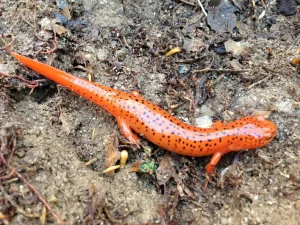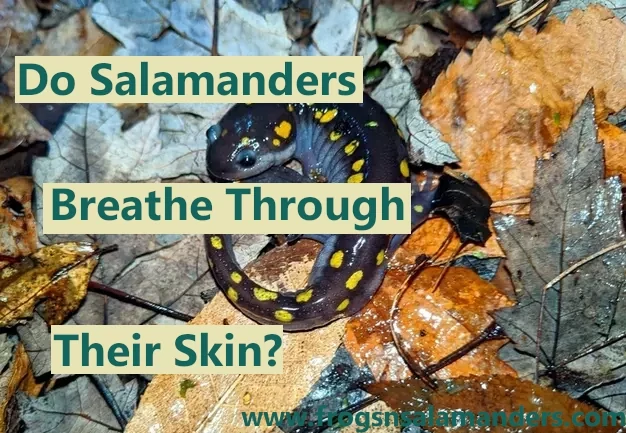Like most amphibians, salamanders have moist, semi-permeable skin essential for many vital functions. But have you ever wondered if salamanders breathe through their skin?
All salamanders can breathe through their skin, in a process known as cutaneous respiration. Some salamanders have lungs, which they use to breathe in addition to their skin, but some are lungless and rely entirely on cutaneous respiration.
Most salamanders start their lives with gills but lose their gills as they mature into adults.
Salamander Larvae Breathe Through Their Gills
Most salamanders (not all) start their lives as tiny embryos inside an egg sack. With time, tiny larvae (baby salamanders) hatch from these eggs.
These larvae are fully aquatic and have external feathery gills attached to either side of their head, just where their necks should have been.

At this stage, salamanders breathe in the water through their gills, just like fish.
Their gills have an extensive capillary network; oxygen dissolved in the water that comes in contact with them is absorbed into their bloodstream via diffusion.
At the same time, carbon dioxide from the bloodstream passes through the gills and is diffused into the water.
Larvae Turn Into Adults
After a few months, to as long as three years in some species, the larvae will go through a process known as metamorphosis and transform into adults.
During metamorphosis, terrestrial (land-dwelling) salamanders will lose their gills and develop strong legs, and other features suited for a terrestrial life.
All Adult Salamanders Breathe Through Their Skin
Once fully transformed into adults, all salamanders have the ability to breathe through their skin.
They have moist semi-permeable skin and very thin absorbent membranes in the mouth and throat. Their skin also has a large network of capillaries and blood vessels close to the surface.
The oxygen that comes in contact with their skin and membranes is absorbed into the bloodstream via diffusion. At the same time, carbon dioxide from the bloodstream passes through the skin and membranes and is diffused into the atmosphere.
This process of “skin breathing” known as cutaneous respiration, is very similar to what happens inside of our lungs.
To efficiently breathe, salamanders have to keep their skin constantly moist by secreting a mucous coating.
They can only absorb oxygen through their skin if the skin stays moist. If it dries up, they can suffocate and die.
Some Adult Salamanders Also Breathe Using Their Lungs
Salamanders such as the spotted and the tiger salamanders will have well-developed lungs when they transform into adults, which they use to breathe, in addition to their skin.

They take air through their nostrils, and down into their lungs.
That said, it is important to note that amphibian lungs are quite primitive when compared to our own.
Salamanders (and other amphibians) do not have a rib cage or diaphragm to move air in and out of their lungs as we do.
Instead, they move air in and out of their lungs through a process known as “gular pumping”, also known as “buccal pumping”.
How Gular Pumping Works
To breathe in, the salamander will lower the floor of its mouth, which causes the throat to expand. Air then rushes into the throat, through the mouth, and the open nostrils.

The salamander will then close its nostrils, and raise the floor of its mouth, which causes the throat to contract, and pushes the air into the lungs.
Once the air is in the lungs, oxygen from the air is then absorbed into the salamanders’ bloodstream. At the same time, carbon dioxide from the bloodstream is diffused into the air.
To breathe out, the salamander will lower the floor of its mouth, which causes the throat to expand and draws the air from the lungs, and into the mouth. It will then open its nostrils, and raise the floor of its mouth, to push the air out of the nostrils.
All this happens in split seconds, and without any conscious effort from the salamander, just like how we breathe without thinking about it.
Other Adult Salamanders Breathe Entirely Through Their Skin
Some salamanders, such as the red and the red-backed salamander do not develop lungs after transforming into adults.
Instead, they develop to breathe entirely through their skin and thin membranes in their mouth and throat. These are called “lungless salamanders”.

Cutaneous respiration (skin breathing) is extremely efficient in lungless salamanders, so it can give them all the oxygen they need.
Adult Aquatic Salamanders Usually Have Gills
Unlike terrestrial salamanders, aquatic salamanders live entirely in the water, even after transforming into adults. This means they have features that are adapted for life in the water, rather than on land.
Aquatic salamanders such as axolotls, sirens, and mudpuppies keep their gills as they develop into adults. They use these gills to breathe in the water, in addition to their skin.
However, sirens and axolotls also have fully functional lungs which they develop as they transform into adults. They use these lungs to occasionally breathe air from the water’s surface.
Some Aquatic Salamanders Do Not Have Gills
Aquatic salamanders such as the hellbender lose their gills as they transform into adults. These salamanders develop to breathe in the water through their very wrinkled skin.

The wrinkles and folds on the hellbender’s skin are important in increasing surface area for absorbing oxygen in the water.
Dissolved oxygen in the water is absorbed through their skin, and into their bloodstream. At the same time, carbon dioxide from the bloodstream passes through their skin and diffuses into the water.
Salamanders Do Not Need as Much Oxygen as We Do
Salamanders are ectothermic (cold-blooded) animals, which means they can not control their body temperature. Instead, their body temperature changes with that of their surroundings.
This is in contrast to endothermic (warm-blooded) creatures, like humans, which can maintain a constant body temperature by producing their own internal, body heat.
To make this heat, warm-blooded animals need food and oxygen. When the temperatures get colder, they will need more oxygen and more energy to produce body heat.
Since salamanders are cold-blooded, they do not use any oxygen to generate internal body heat. This means, their oxygen needs are not as high as those of warm-blooded animals.
In the winter, salamanders will brumate (hibernate) to protect themselves from the freezing temperatures. During brumation, their heart rate, breathing rate, and overall metabolic rate will dramatically drop.
Brumating salamanders will have extremely low oxygen needs because their bodies use very little energy.
Conclusion
There are lots of different salamander species, so the exact way a salamander will breathe will depend on the species.
However, all salamanders can breathe through their skin, regardless of their species or habitat.
So, the next time you see a salamander, you can be sure that it breathes through its skin!
Sources:
Tattersall GJ. Skin Breathing in Amphibians. In: Aird WC, ed. Endothelial Biomedicine. Cambridge University Press; 2007:85-91.
RACHEL S. SIMONS, WALLACE O. BENNETT AND ELIZABETH L. BRAINERD (2000). MECHANICS OF LUNG VENTILATION IN A POST-METAMORPHIC SALAMANDER (PDF).

